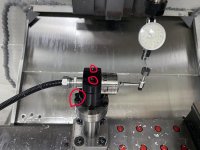Speedie
Stainless
- Joined
- Feb 24, 2009
- Location
- Midwestern MN/Wi USA
So working with a table probe I noticed it was tilted a few degrees. Looks like it got hit by a chunk of steel and tilted the probe head. It is a wireless tool touch probe. How can these stay accurate when you can fairly easily push and pull them out of position. I know they cannot stay accurate but how does one re center the 90 degeee probe tip?? This is on a 50 taper haas vf5


